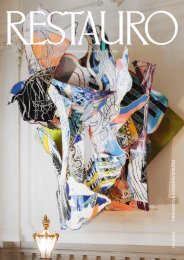topos113
uban mutation
uban mutation
Erfolgreiche ePaper selbst erstellen
Machen Sie aus Ihren PDF Publikationen ein blätterbares Flipbook mit unserer einzigartigen Google optimierten e-Paper Software.
Opinion<br />
The New European Bauhaus forms part of the<br />
European Green Deal’s action plan that aims to<br />
reduce greenhouse gas emissions by 55 per cent<br />
by 2030 and make Europe climate-neutral by<br />
2050. It will be financed through the EU’s 750<br />
billion-euro NextGenerationEU coronavirus recovery<br />
plan. In her State of the Union address<br />
Ursula von der Leyen called for a “Renovation<br />
Wave” to help Europe move to a circular economy.<br />
She stressed the importance of the project’s<br />
environmental, economic and cultural aspects,<br />
as well as the new Bauhaus’ role as “a co-creation<br />
space where architects, artists, students, engineers,<br />
designers work together to make that happen”.<br />
With the announcement, the Commission<br />
acknowledged two notable points. Firstly, the<br />
idea of Baukultur – architecture and construction<br />
as a cultural activity including its social, economic,<br />
ecological and aesthetic dimension – and<br />
its importance to society, which had been previously<br />
recognised by European Ministers of Culture<br />
in their Davos Declaration in 2018. And secondly,<br />
the key role the construction industry<br />
plays in emissions reduction and the creation of<br />
sustainable and climate-neutral cities and communities.<br />
Buildings account for around 40 per<br />
cent of the EU’s energy consumption and 36 per<br />
cent of the EU’s greenhouse gas emissions. With<br />
its Renovation Wave strategy, the EU aims to improve<br />
the energy performance of buildings<br />
through stronger regulations and the use of innovative<br />
materials, create green jobs and promote<br />
neighbourhood-based approaches and affordable<br />
housing. The New European Bauhaus<br />
“is intended to be a bridge between the world of<br />
science and technology and the world of art and<br />
culture”. Many details of this vision of a 21 st century<br />
Bauhaus remain hazy. A recently published<br />
fact sheet describes the New European Bauhaus<br />
as a forum for discussion, a space for art and culture,<br />
an experimentation lab, a hub for global<br />
networks and experts, and a contact point for<br />
citizens. In the initial stages, five projects will be<br />
created in different member states of the Union.<br />
The second phase from 2023 onwards will seek<br />
to establish projects and a network both inside<br />
and outside Europe. These pilot projects will focus<br />
on aspects such as natural building materials,<br />
energy efficiency, mobility and digital innovation.<br />
While a further exploration of natural and<br />
sustainable materials as well as the principles of a<br />
circular economy in architecture is commendable,<br />
a lack of political will to enforce a green<br />
transformation of the building sector is arguably<br />
more problematic. Can the European Green<br />
Deal lead to a change in policies and a muchneeded<br />
reform of the construction industry – a<br />
sector that is known to be slow to innovate?<br />
Though the original Bauhaus might not provide<br />
a model for ecological design, its holistic approach,<br />
experimental and innovative character<br />
and ideal of a socially responsible society could<br />
point the way. Beyond its aesthetic, the Bauhaus<br />
had an important political dimension. Its influence<br />
on both architecture and society is still apparent<br />
today. A New European Bauhaus that<br />
draws on the collective spirit of its predecessor<br />
and is based on co-creation and co-design might<br />
be lead to broad engagement and build “a tomorrow<br />
that is greener, more beautiful and humane”,<br />
as suggested by von der Leyen. The New<br />
European Bauhaus’ impact is supposed to reach<br />
beyond Europe’s borders, as “Europe is to lead<br />
the way in the twin green and digital transition”.<br />
A dialogue between cities on a global level is desirable,<br />
yet it needs to be a two-way conversation.<br />
There is much we can learn from cities in the<br />
Global South with regard to climate change adaptation,<br />
community building, rapid urbanisation<br />
and resilience. Good design can indeed improve<br />
lives. During the current pandemic crisis,<br />
the need for affordable high-quality housing and<br />
accessible green public space has become evident.<br />
We have to rethink how we build and inhabit<br />
our cities. Whether the European Green<br />
Deal and the New European Bauhaus can lead to<br />
systemic change and fight climate change, as it<br />
claims, remains to be seen. The EU’s credibility<br />
has been undermined by the recent approval of a<br />
new EU agricultural policy that critics claim will<br />
worsen the climate crisis, while EU environment<br />
ministers failed to strike a deal on its 2030 emissions<br />
reduction target. What has become clear is<br />
that to bring about systematic change and create<br />
sustainable, resilient and equitable cities, architects<br />
and urban designers need to be involved in<br />
decision-making processes. Let’s hope that the<br />
New European Bauhaus will be the first step.<br />
SIGRID EHRMANN holds a diploma degree in<br />
landscape architecture of the Technical University of<br />
Berlin. She works as a freelance landscape architect,<br />
environmental planner and writer. Based<br />
in Barcelona, a city renowned for its architecture,<br />
innovative urban transformations and creative<br />
scene, she conducts research on a variety of topics,<br />
ranging from climate change adaptation, green<br />
infrastructure and urban strategies to detailed<br />
landscape architecture and public space projects.<br />
topos 011


















